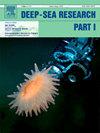Bacterial community characterization and relationship in the gut of deep-sea holothurians and sediment from the Northern Indian Ocean
IF 2.1
3区 地球科学
Q2 OCEANOGRAPHY
Deep-Sea Research Part I-Oceanographic Research Papers
Pub Date : 2025-06-18
DOI:10.1016/j.dsr.2025.104546
引用次数: 0
Abstract
Sea cucumbers, widely distributed benthic invertebrates in diverse deep-sea habitats, rely on their gut bacterial communities for essential functions including energy metabolism, biological adaptation, and health. However, the gut bacterial community of deep-sea holothurians in the Indian Ocean remains poorly understood. We used 16S rRNA gene sequencing to characterize bacterial communities in the guts of sea cucumbers and surrounding sediments from two distinct regions of the northern Indian Ocean: the Ninety-East Ridge and the Arabian Sea Basin. This study investigates the composition, diversity, predicted functions, co-occurrence networks, and assembly processes of gut bacterial communities. Alpha diversity of gut bacterial communities did not differ significantly between the two regions. Based on principal coordinate analysis, the bacterial communities of gut formed a distinct cluster from the sediment communities. Actinobacteriota, Proteobacteria, Firmicutes, Chloroflexi, and Bacteroidota were the dominant phyla in both gut and sediment bacterial communities. In the Ninety-East Ridge, the gut microbial network exhibited a higher proportion of positive correlation than the sediment network, suggesting a greater potential for cooperative interactions. Compared to sediment communities, functional predictions indicated that gut communities were enriched in metabolic pathways, including those for amino acid, glycan, vitamin, and lipid metabolism. Stochastic processes were predominant in gut bacterial community assembly, whereas deterministic processes dominated in sediment bacterial communities. This study provides critical insights into the gut microbiota of deep-sea holothurians, advancing our understanding of microbial ecology in extreme marine environments.
北印度洋深海海棠肠道细菌群落特征及其与沉积物的关系
海参是广泛分布于不同深海栖息地的底栖无脊椎动物,它们依靠肠道细菌群落来实现能量代谢、生物适应和健康等基本功能。然而,人们对印度洋深海全息鱼的肠道细菌群落知之甚少。我们使用16S rRNA基因测序来表征来自北印度洋两个不同区域的海参内脏和周围沉积物中的细菌群落:九十东脊和阿拉伯海盆地。本研究探讨了肠道细菌群落的组成、多样性、预测功能、共生网络和组装过程。两个地区肠道细菌群落的α多样性无显著差异。基于主坐标分析,肠道细菌群落与沉积物群落形成了明显的集群。放线菌门、变形菌门、厚壁菌门、绿菌门和拟杆菌门是肠道和沉积物细菌群落的优势门。在90 east Ridge,肠道微生物网络表现出比沉积物网络更高的正相关比例,表明更大的合作相互作用潜力。与沉积物群落相比,功能预测表明肠道群落在代谢途径中丰富,包括氨基酸、聚糖、维生素和脂质代谢途径。随机过程在肠道细菌群落组装中占主导地位,而确定性过程在沉积物细菌群落中占主导地位。这项研究为深海全息鱼的肠道微生物群提供了重要的见解,促进了我们对极端海洋环境下微生物生态的理解。
本文章由计算机程序翻译,如有差异,请以英文原文为准。
求助全文
约1分钟内获得全文
求助全文
来源期刊
CiteScore
4.60
自引率
4.20%
发文量
144
审稿时长
18.3 weeks
期刊介绍:
Deep-Sea Research Part I: Oceanographic Research Papers is devoted to the publication of the results of original scientific research, including theoretical work of evident oceanographic applicability; and the solution of instrumental or methodological problems with evidence of successful use. The journal is distinguished by its interdisciplinary nature and its breadth, covering the geological, physical, chemical and biological aspects of the ocean and its boundaries with the sea floor and the atmosphere. In addition to regular "Research Papers" and "Instruments and Methods" papers, briefer communications may be published as "Notes". Supplemental matter, such as extensive data tables or graphs and multimedia content, may be published as electronic appendices.

 求助内容:
求助内容: 应助结果提醒方式:
应助结果提醒方式:


